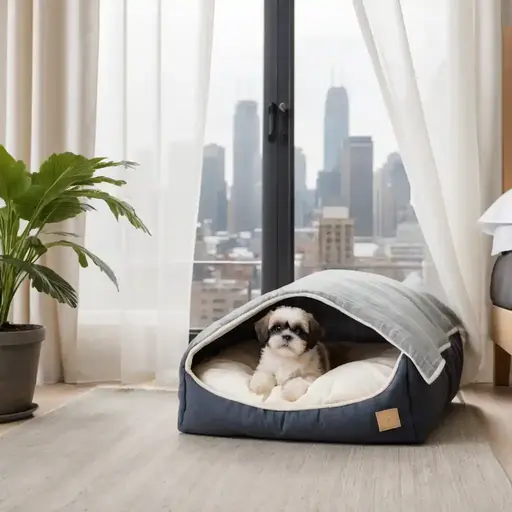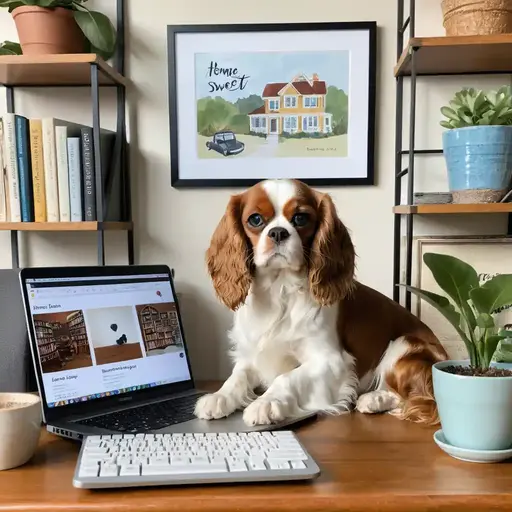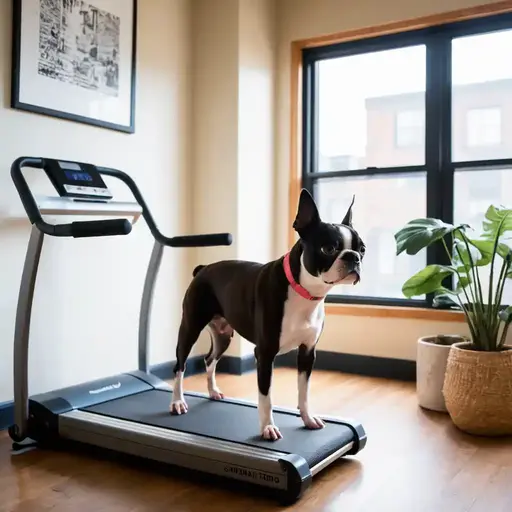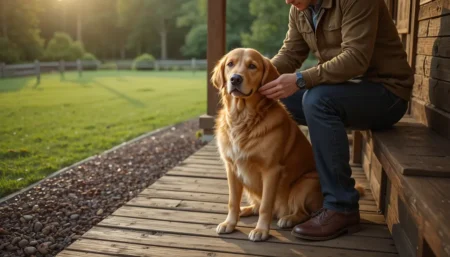The top 10 dog breeds for apartment living include the Cavalier King Charles Spaniel, Italian Greyhound, French Bulldog, Bichon Frisé, Pug, Boston Terrier, Dachshund, Basset Hound, Shih Tzu, and Pomeranian.
These breeds are ideal for small spaces due to their adaptable temperaments, moderate energy levels, and minimal noise tendencies. Whether you’re a busy professional or a first-time pet owner, selecting from these dog breeds for apartment living can lead to a harmonious urban lifestyle filled with companionship and joy.
In this guide, we’ll explore why these breeds thrive in apartments, how to choose the right one, and practical tips for creating a pet-friendly home.
You’ll also find advice on training, health, legal considerations, and more to ensure a smooth experience.
Why Dogs Thrive in Apartment Living
Many people assume apartments and dogs don’t mix, but the right dog breeds for apartment living can flourish in compact urban spaces. With thoughtful selection and care, these breeds adapt well, turning limited square footage into a cozy haven.
Factors like low energy needs and quiet dispositions make them perfect fits for city dwellers.
Urban living often brings challenges like noise restrictions and small yards, but apartment-friendly dogs counter these with their flexibility.
Studies show that interacting with dogs reduces stress hormones like cortisol and boosts feel-good chemicals like oxytocin, enhancing mental well-being in high-paced environments.
This adaptability not only helps dogs thrive but also enriches owners’ lives through daily routines and emotional support.
Key Reasons These Breeds Excel
- Compact Size for Space Efficiency: Smaller breeds require less room to move, ideal for studios or one-bedrooms. For example, many fit comfortably in cozy corners without feeling cramped.
- Balanced Energy Levels: They enjoy short play sessions but are content lounging, minimizing the need for large outdoor areas.
- Quiet Companionship: Low barking keeps neighbors happy while providing alert, affectionate company.
- Health and Mood Boosts: Dogs encourage walks, which promote physical activity, and their presence lowers anxiety, as confirmed by research on pet-human bonds.
By matching a breed’s traits to your routine, apartment living becomes a rewarding adventure rather than a limitation.

The Perks of Apartment Living with a Canine Companion
Owning a dog in an apartment offers unique advantages that go beyond basic pet ownership. These dog breeds for apartment living provide emotional anchors and practical benefits tailored to urban life.
From reducing isolation to adding security, they transform small spaces into vibrant homes.
Research highlights how dogs improve mental health by easing loneliness and fostering routines. In compact settings, their presence encourages mindfulness and daily movement, making apartment life more fulfilling.
Let’s break down the key perks that make these companions invaluable.
Top Benefits for Urban Pet Owners
- Emotional Support in Busy Lives: Dogs combat solitude with unwavering loyalty, boosting oxytocin levels to reduce stress and anxiety. This is especially helpful for solo dwellers or remote workers in apartments.
- Built-In Security Features: Many breeds offer subtle vigilance without excessive noise, alerting you to unusual sounds while maintaining peace in shared buildings.
- Motivation for Active Habits: Even low-energy breeds prompt short walks or indoor play, integrating exercise seamlessly into your schedule and improving overall fitness.
- Social Connections in Community Spaces: A friendly dog sparks conversations in elevators or parks, helping build neighborly ties and reduce urban isolation.
These perks highlight how dog breeds for apartment living enhance daily rhythms, turning potential drawbacks like limited space into opportunities for deeper bonds.

Choosing the Right Breed for Your Apartment
Selecting dog breeds for apartment living starts with evaluating your lifestyle and space. Key traits like size and temperament ensure a good match, preventing issues like excessive barking or boredom. Focus on breeds that align with your daily routine for long-term harmony.
Not all dogs suit small spaces, so consider factors beyond cuteness. Prioritize adaptability and low maintenance to avoid common mismatches. Below are essential criteria to guide your decision.
Essential Criteria to Consider
- Size and Space Needs: Opt for small to medium breeds that don’t require vast areas. Compact dogs like those under 30 pounds fit well in tight quarters without feeling restricted.
- Energy and Activity Levels: Choose moderate to low-energy breeds that thrive on short walks rather than long runs, suiting busy schedules.
- Barking and Noise Tolerance: Quiet dispositions are crucial in shared walls; avoid vocal breeds to maintain neighbor harmony.
- Temperament and Sociability: Laid-back, friendly dogs bond easily and handle solitude, reducing separation anxiety.
- Grooming and Shedding: Low-shedding options simplify cleanup in small spaces, where fur accumulates quickly.
- Independence and Trainability: Breeds that tolerate alone time and learn quickly adapt better to apartment routines.
Weighing these elements helps you find a breed that complements your life, ensuring mutual happiness.

Top 10 Dog Breeds for Apartment Living
After understanding the selection criteria, it’s time to meet the standout dog breeds for apartment living. These breeds combine charm, adaptability, and practicality, proving that small spaces can host big personalities.
Each offers unique traits suited to urban environments, from low maintenance to affectionate companionship.
Expand your knowledge with detailed profiles below. We’ve included size, energy levels, pros, cons, and care tips based on expert recommendations from sources like the American Kennel Club.
- Cavalier King Charles Spaniel
This affectionate breed is known for its gentle nature and love of cuddles. Size: Small to medium (13-18 pounds). Energy: Low to moderate.
Pros: Adaptable, friendly with everyone, minimal barking.
Cons: Prone to heart issues; needs regular vet checkups.
Care Tips: Provide short daily walks and grooming every few weeks to keep their silky coat tangle-free. Ideal for quiet homes. - Italian Greyhound
Sleek and serene, these miniature sighthounds are elegant couch companions. Size: Small (7-14 pounds). Energy: Low.
Pros: Quiet, low-shedding, thrives in warm indoor spaces.
Cons: Fragile bones; avoid rough play.
Care Tips: Offer cozy blankets for lounging and short bursts of indoor zoomies to satisfy their occasional energy spurts. - French Bulldog
Playful yet relaxed, Frenchies are urban favorites with bat-like ears. Size: Small (16-28 pounds). Energy: Low.
Pros: Quiet, affectionate, minimal exercise needs.
Cons: Breathing issues in heat; keep cool.
Care Tips: Schedule brief walks and monitor for overheating; their short coat requires little grooming. - Bichon Frisé
Cheerful and hypoallergenic, these fluffy pups bring joy to any space. Size: Small (12-18 pounds). Energy: Moderate.
Pros: Low-shedding, sociable, easy to train.
Cons: Requires regular grooming to prevent mats.
Care Tips: Brush daily and provide puzzle toys for mental stimulation; they’re great for allergy sufferers. - Pug
Wrinkled and mellow, Pugs are comical companions with big hearts. Size: Small (14-18 pounds). Energy: Low.
Pros: Calm, loving, adapts to routines easily.
Cons: Prone to obesity; watch diet.
Care Tips: Offer short play sessions and clean facial folds weekly to prevent infections. - Boston Terrier
Known as the “American Gentleman,” these tuxedo-clad dogs are lively yet composed. Size: Small (12-25 pounds). Energy: Moderate.
Pros: Adaptable, friendly, low grooming needs.
Cons: Can be gassy; choose quality food.
Care Tips: Engage in indoor games and socialize early to enhance their sociable nature. - Dachshund
Bold and quirky, these “wiener dogs” pack personality into a long body. Size: Small (11-32 pounds). Energy: Moderate.
Pros: Loyal, adaptable to indoor life.
Cons: Back problems; avoid jumping.
Care Tips: Use ramps for furniture and provide digging toys to channel their instincts. - Basset Hound
Droopy-eyed and laid-back, Bassets are soulful loungers. Size: Medium (40-65 pounds). Energy: Low.
Pros: Calm, tolerant of solitude.
Cons: Stubborn; needs patient training.
Care Tips: Clean ears weekly to prevent infections and offer scent games for mental fun. - Shih Tzu
Tiny lions with flowing coats, Shih Tzus are devoted lap dogs. Size: Small (9-16 pounds). Energy: Low.
Pros: Quiet, affectionate, low exercise.
Cons: Grooming-intensive coat.
Care Tips: Brush daily and tie topknots to keep eyes clear; perfect for cuddle sessions. - Pomeranian
Pint-sized fluff balls bursting with spunk. Size: Small (3-7 pounds). Energy: Moderate.
Pros: Playful, compact, alert watchdogs.
Cons: Can be yappy; train early.
Care Tips: Provide indoor toys and groom regularly to manage shedding.
These dog breeds for apartment living offer diverse options, ensuring you find a perfect match.

Creating a Dog-Friendly Apartment Sanctuary
Transforming your apartment into a safe, stimulating space is essential for dog breeds for apartment living. Simple adjustments prioritize comfort and safety, respecting shared environments. This setup fosters well-being while minimizing mess and hazards.
Start by assessing your layout for pet-proofing opportunities. Designate zones to create structure, and incorporate enrichment for happiness.
Safety and Comfort Essentials
- Pet-Proofing Basics: Secure cords, store toxins high, and use gates to block dangers like balconies.
- Cozy Rest Areas: Place a supportive bed in a quiet spot; orthopedic options suit older breeds.
- Feeding and Play Stations: Use mats to contain spills and bins for toys, keeping clutter low.
- Potty Solutions: Indoor pads or litter boxes work for puppies or bad weather.
Noise and Enrichment Strategies
Add rugs for soundproofing and toys for distraction. Vertical shelves provide climbing for agile breeds like Italian Greyhounds.
Training and Exercise: Building Harmony Indoors
Effective training and exercise are key for dog breeds for apartment living to stay balanced in small spaces. Consistency builds good habits, preventing boredom-related issues. Focus on positive methods to create a calm, well-behaved companion.
Indoor activities keep energy in check without needing a yard. Tailor routines to your breed’s needs for optimal results.
Obedience and Indoor Fun
- Basic Commands: Teach “sit” and “quiet” with treats; ideal for noise-sensitive apartments.
- Exercise Ideas: Use puzzles, hallway fetch, or agility setups with furniture.
- Barking Control: Redirect with toys and reward silence.
Socialize through controlled exposures to build confidence in shared areas.
Health and Wellness in Small Spaces
Maintaining health for dog breeds for apartment living involves proactive routines beyond basic care. Regular activity and mental engagement prevent common issues like obesity. Holistic approaches ensure vitality in confined settings.
Studies link exercise to better brain function and joint health. Incorporate variety for comprehensive wellness.
Exercise and Mental Boosts
- Physical Activities: Short stair climbs or balance games strengthen muscles.
- Cognitive Tools: Puzzle feeders and scent hunts keep minds sharp.
- Preventive Care: Monitor weight and dental health with chews.
Vet visits catch breed-specific concerns early.
Legal and Community Tips
Navigating legal rules and neighbor relations is crucial for dog breeds for apartment living. Understanding rights prevents conflicts in rentals. Build positive ties for a supportive community.
The Fair Housing Act protects against pet discrimination for service animals, but standard pets follow lease terms. Stay informed on vaccinations and licenses.
Compliance and Etiquette
- Lease Reviews: Check breed restrictions and fees.
- Community Practices: Clean up promptly and respect quiet hours.
- Communication: Introduce your dog to neighbors early.
A pet portfolio with records eases inspections.

Troubleshooting Common Apartment Challenges
Even with ideal dog breeds for apartment living, hurdles like noise or space arise. Proactive solutions turn issues into routines. Address them early for smooth coexistence.
Common problems include elevator stress and boredom. Use training and tools to mitigate.
Practical Fixes
- Elevator Training: Practice calm sits with rewards.
- Noise Reduction: White noise machines mask triggers.
- Space Optimization: Rotate toys and use vertical storage.
Open dialogue with neighbors resolves tensions quickly.
Common Mistakes to Avoid When Choosing and Living with a Dog in an Apartment
Many new owners overlook key pitfalls when selecting dog breeds for apartment living. Avoiding these errors ensures a better fit and fewer regrets. Awareness leads to informed decisions and happier outcomes.
Rushing into adoption without research tops the list. Consider long-term needs for success.
Top Mistakes and How to Dodge Them
- Ignoring Breed Energy Mismatch: High-energy dogs are frustrated in small spaces; choose low-key options like French Bulldogs.
- Skipping Landlord Checks: Breed bans surprise; review policies first.
- Neglecting Training: Untrained pups bark excessively; start obedience early.
- Overlooking Grooming Needs: High-maintenance coats overwhelm; opt for low-shedders.
- Forgetting Socialization: Isolated dogs get anxious; expose them gradually to urban sights.
By sidestepping these, you’ll foster a thriving partnership.
FAQs
What makes a dog breed suitable for apartment living?
Dog breeds for apartment living typically have low to moderate energy, minimal barking, and small to medium sizes. They adapt well to indoor routines and tolerate solitude during work hours.
How much exercise do apartment dogs need?
Most need 20-30 minutes of daily activity, like short walks or indoor play. Breeds like Basset Hounds require less, while Pomeranians enjoy more interactive games to stay happy.
Are there hypoallergenic options among these breeds?
Yes, the Bichon Frisé is hypoallergenic with low shedding. It’s great for allergy-prone owners, but regular grooming keeps their coat in check.
Can large breeds live in apartments?
Some, like Greyhounds, can be if they’re low-energy couch potatoes. However, stick to smaller dog breeds for apartment living to avoid space issues and landlord restrictions.
What if my dog barks a lot in the apartment?
Identify triggers like door noises and use training with positive rewards. Puzzle toys distract, and desensitization to sounds helps reduce excessive barking over time.
Conclusion
The top dog breeds for apartment living, from affectionate Cavaliers to mellow Pugs, offer companionship without overwhelming small spaces.
By focusing on traits like low energy and quiet temperaments, plus tips for setup, training, and health, you’ll create a fulfilling home.
Start by researching breeds on sites like the AKC, then visit shelters—your perfect urban companion awaits for years of joy.






